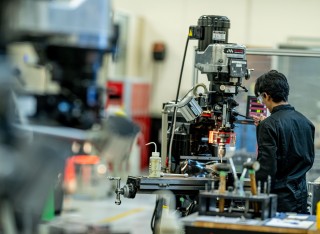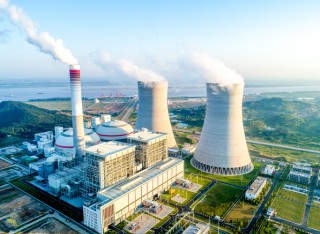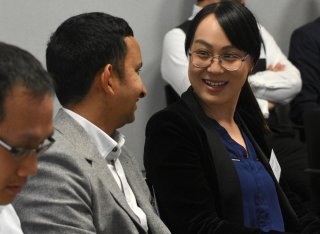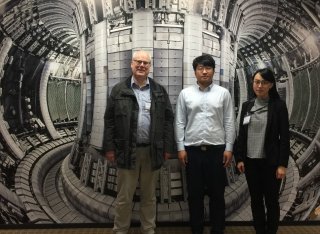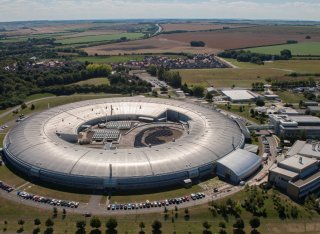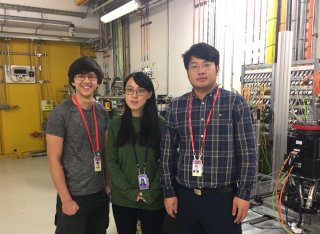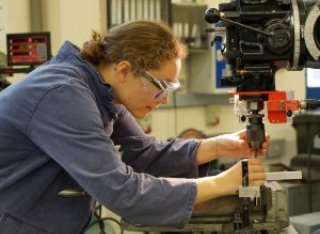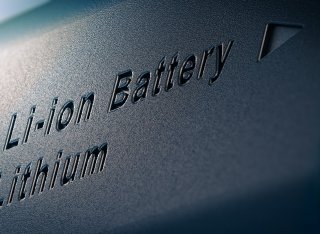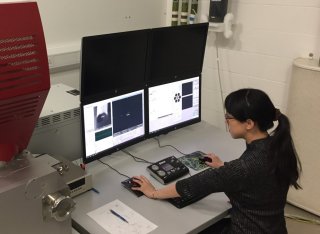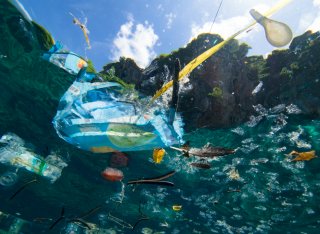
Dr Tan Sui
Academic and research departments
School of Mechanical Engineering Sciences, Faculty of Engineering and Physical Sciences.About
Biography
Dr Tan Sui is an Associate Professor (Reader) in Materials Engineering, the School of Mechanical Engineering Sciences at the University of Surrey, UK. She holds Royal Academy of Engineering Industrial Fellowship and visiting role at the National Physical Laboratory, UK. She is also a Chartered Scientist (CSci) and a Fellow (FIMMM) of the Institute of Materials, Minerals and Mining (IoM3). She is a Fellow of the Women's Engineering Society (FWES).
Dr Sui's research efforts have been devoted to characterising, modelling and understanding the intricate links between structure and mechanical behaviour, property degradation and failure mechanisms in complex material systems. These systems include nuclear fusion alloys and bioinspired materials, with the aim of enhancing design and prolonging their operational lifetime. Her expertise includes advanced micro/nano-mechanical testing, multi-scale residual stress evaluation, engineering microscopy, large-scale facility: synchrotron X-ray and neutron techniques and modelling with finite element methods and machine learning for structural integrity.
University roles and responsibilities
- Senate Academic Representative
- Deputy Head of the Centre for Engineering Materials
- UK Education Cluster Steering Group member for Women's Engineering Society (WES)
Affiliations and memberships
ResearchResearch interests
Dr Sui's research portfolio is focused on probing the processing-structure-residual stress relationship and micromechanical mechanism of failure in nuclear fusion alloys. Her research areas also include investigating the structure property evolution and structural integrity of hierarchical natural and bioinspired materials. Her expertise includes synchrotron X-ray with multi-modal correlative microscopy and multi-scale modelling. Her research vision is to characterise and understand the intricate links between structure and mechanical property in these material systems at different length scales, as this is essential for development towards improved design and extended functionality for future applications.
Research projects
- Capital equipment, a) in-SEM & in situ Deben micromechanical tester; b) in-SEM & in situ Alemnis nanoindenter; c) Olympus elastic modulus tester.
- Diamond Light Source joint PhD studentship, 2023, PI.
- STFC Access to Large-scale Facilities, 30 shifts beamtime allocation in-kind funding, I22, I18 beamlines at the DLS, 2022, PI.
- Henry Royce Institute Materials Challenge Accelerator Programme, 2022, PI.
- UKAEA research project, 2022, PI.
- EPSRC iCASE studentship, 2022, PI.
- DTP studentship, 2022, PI.
- University Breaking Barriers Studentship award, 2022, PI.
- 2x EPSRC IAA Placements, UKAEA, DLS, 2022, PI.
- Sustainability Research Grant, 2022, PI.
- Public Engagement Fund, 2022, PI.
- ICURe Innovation to Commercialisation, Innovate UK, 2021, PI.
- National GSK Award Oral and Dental Research Trust, 2021, PI.
- IAS Fellowship Grant, 2021, PI.
- UKRI - CoA grant, 2021, PI.
- The Royal Society International Exchanges Cost Share (NSFC) scheme (IEC\NSFC\191003) 2020, PI.
- UKRI ImagingBioPro Network Proof of Concept Award (PoCA) Funding, 2020, PI.
- Doctoral College Studentship Award with UKAEA, 2020, PI.
- Capital Award, Alemnis in situ nanoindenter system upgrade, 2020, PI.
- EPSRC (EP/S022813/1), Understanding and enhancing the mechanical performance of bioinspired zirconia-based dental materials, 2019, PI.
- Strategic Priorities Funding, 2019, PI.
- Diamond Light Source (DLS) joint international PhD studentship, 3.5 years, 2019, PI.
- TESCAN Brno s.r.o., Auto-DIC software, 2019, PI.
- Doctoral College Studentship Award, 3 years with UKAEA, 2018, PI.
- Capital Award, Deben Microtest 5000 system, A miniature thermo-mechanical stage (150N, 660N, 2KN, 5KN) for optical, electron, scanning probe and synchrotron X-ray microscopies with heating-cooling capabilities (from -20oC to 160oC), 2018, PI.
- Over 40 experimental visits (in-kind funding ~£80k per visit) to use large scale facilities, such as Diamond Light Source, ISIS Neutron and Muon Source, 2018-2021, CI/PI.
- EPSRC (EP/P005381/1), 2017-2021, R-CI.
Research collaborations
Research partners: 11 industries and national laboratories/centres, as well as 7 universities and institutes. These include CCFE/UKAEA, NPL, Deben UK, TESCAN Brno s.r.o. and Alemnis AG, as well as national large-scale facilities at Diamond Light Source (DLS) and ISIS Neutron and Muon Source.
Research interests
Dr Sui's research portfolio is focused on probing the processing-structure-residual stress relationship and micromechanical mechanism of failure in nuclear fusion alloys. Her research areas also include investigating the structure property evolution and structural integrity of hierarchical natural and bioinspired materials. Her expertise includes synchrotron X-ray with multi-modal correlative microscopy and multi-scale modelling. Her research vision is to characterise and understand the intricate links between structure and mechanical property in these material systems at different length scales, as this is essential for development towards improved design and extended functionality for future applications.
Research projects
- Capital equipment, a) in-SEM & in situ Deben micromechanical tester; b) in-SEM & in situ Alemnis nanoindenter; c) Olympus elastic modulus tester.
- Diamond Light Source joint PhD studentship, 2023, PI.
- STFC Access to Large-scale Facilities, 30 shifts beamtime allocation in-kind funding, I22, I18 beamlines at the DLS, 2022, PI.
- Henry Royce Institute Materials Challenge Accelerator Programme, 2022, PI.
- UKAEA research project, 2022, PI.
- EPSRC iCASE studentship, 2022, PI.
- DTP studentship, 2022, PI.
- University Breaking Barriers Studentship award, 2022, PI.
- 2x EPSRC IAA Placements, UKAEA, DLS, 2022, PI.
- Sustainability Research Grant, 2022, PI.
- Public Engagement Fund, 2022, PI.
- ICURe Innovation to Commercialisation, Innovate UK, 2021, PI.
- National GSK Award Oral and Dental Research Trust, 2021, PI.
- IAS Fellowship Grant, 2021, PI.
- UKRI - CoA grant, 2021, PI.
- The Royal Society International Exchanges Cost Share (NSFC) scheme (IEC\NSFC\191003) 2020, PI.
- UKRI ImagingBioPro Network Proof of Concept Award (PoCA) Funding, 2020, PI.
- Doctoral College Studentship Award with UKAEA, 2020, PI.
- Capital Award, Alemnis in situ nanoindenter system upgrade, 2020, PI.
- EPSRC (EP/S022813/1), Understanding and enhancing the mechanical performance of bioinspired zirconia-based dental materials, 2019, PI.
- Strategic Priorities Funding, 2019, PI.
- Diamond Light Source (DLS) joint international PhD studentship, 3.5 years, 2019, PI.
- TESCAN Brno s.r.o., Auto-DIC software, 2019, PI.
- Doctoral College Studentship Award, 3 years with UKAEA, 2018, PI.
- Capital Award, Deben Microtest 5000 system, A miniature thermo-mechanical stage (150N, 660N, 2KN, 5KN) for optical, electron, scanning probe and synchrotron X-ray microscopies with heating-cooling capabilities (from -20oC to 160oC), 2018, PI.
- Over 40 experimental visits (in-kind funding ~£80k per visit) to use large scale facilities, such as Diamond Light Source, ISIS Neutron and Muon Source, 2018-2021, CI/PI.
- EPSRC (EP/P005381/1), 2017-2021, R-CI.
Research collaborations
Research partners: 11 industries and national laboratories/centres, as well as 7 universities and institutes. These include CCFE/UKAEA, NPL, Deben UK, TESCAN Brno s.r.o. and Alemnis AG, as well as national large-scale facilities at Diamond Light Source (DLS) and ISIS Neutron and Muon Source.
Supervision
Postgraduate research supervision
Research Fellow (Line manager, PI):
Dr Bin Zhu (2022 - )
"Multi-scale microstructure and mechanical characterisation of dissimilar joints for fusion", funded by UKAEA.
Dr Nathanael Leung (2022 - 2023)
"Machine learning-powered finer scale residual stress assessment for lifespan extension of nuclear materials", funded by Henry Royce Institue.
Dr Hongbo Wan (2021)
"Bioinspired dental composite materials", funded by UKRI-CoA.
Dr Hani El-Kadri (2020)
"Multi-scale structural and mechanical characterisation in bioinspired polyurethane-based artificial human skin", funded by ImagingBioPro Network.
Dr Jingyi Mo (2019 - 2021)
"Understanding and enhancing the mechanical performance of bioinspired zirconia-based dental materials", funded by EPSRC.
PhD students (Main supervisor, PI):
Uyanga Jargalsaikhan (2023 - )
"Investigation of microstructure, micro-residual stress and strain evolution in novel bioinspired biocomposites using time-resolved 3D micro-X-ray diffraction tomography"
David England (2022 - )
"Probabilistic treatment of multi-scale residual stress and defects in fracture assessment of dissimilar joints for nuclear fusion"
Brandon Steel (2022 - )
"Modelling residual stress and mechanical performance of advanced joints for nuclear fusion"
Aqsa Qambrani (2022 - )
"Develop reliable detection and treatment for dental caries"
Omar Mohamed (2021 - )
"Microstructure and micromechanics of dissimilar joints for fusion power plants"
Tayyaba Rabnawaz (2019 - 2024)
"Nanostructure surveys of natural and biomimetic dental tissues by 3D SAXS tensor tomography"
Urangua Jargalsaikhan (2019 - 2023)
"Microstructure and Micromechanics of Bioinspired Composites for Next Generation Dental Crowns"
Nathanael Leung (2018 - 2022)
"Revealing the Structure and Function of Natural and Bioinspired Biocomposites Using Synchrotron X-ray Tomography Techniques"
Bin Zhu (2018 - 2022)
"Microstructures, multi-scale residual stress and mechanical performance evaluation of laser-welded Eurofer97 steel for fusion power plants"
Co-supervisor:
Ryan Banks (2022 - )
"Clinician-in-the-loop AI-assisted Dental Disease Detection with Radiography"
Shaoyin Li (2021 - )
"UV-Micro-Patternable Ionogel Electrolytes: Design, Preparation, and Applications in Energy Storage Devices"
Xuhui Yao (2019 - 2023)
"Interface Engineering and Advanced Characterisation for Solid-State Li Metal Batteries"
Jauffrey Lescoffit (2018 - 2024)
"Understanding stress profiles in multilayer PVD coatings"
Thomas Fekadu Kebede (2018 - 2023)
"Critical defect identification and characterisation in Titanium Matrix"
Teaching
‘Learning, Teaching and Assessing’ certificate from SEDA (Oxford), aligned to the UK Professional Standards Framework at Descriptor 2 (equivalent to Fellow of the Higher Education Academy), 2017.
ENG1063 (FHEQ Level 4): Materials & Statics, Module leader
ENG2093 (FHEQ Level 5): Non-Destructive Testing
ENGM261 (FHEQ Level 7): Medical Implants and Biomaterials Applications
Supervision: Supervised 37 BEng/MEng/MSc/Summer intern/PTY students.
Sustainable development goals
My research interests are related to the following:
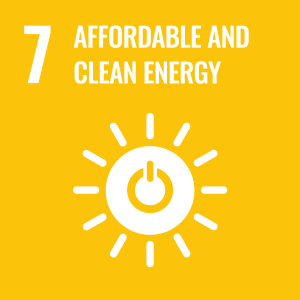
Publications
Dental caries is the most prevalent oral disease that causes structural and compositional changes of the dental hard tissues due to a chronic demineralisation (combined with possible phases of remineralisation) process. Though considerable efforts have been directed at studying natural and artificial carious lesions, most characterisations remain either constrained to 2D analyses or have been unable to achieve fine resolution in 3D due to limited field of view. To overcome this challenge, the present study combined X-ray diffraction (XRD) and scanning transmission X-ray microscopy (STXM) tomography techniques to analyse the mineral density, scattering intensity, and crystallite size in normal, carious, 30 % artificially demineralised, and 50 % artificially demineralised dentine. Combined XRD and STXM tomography was performed on the I18 beamline at Diamond Light Source, using a 15 keV monochromatic beam with 2 × 2 µm spotsize and scanning with translation steps of 2 µm, providing a reconstructed voxel size of 2 × 2 × 2 µm. Natural carious dentine showed a reduction in hydroxyapatite (HAp) crystallite size due to chronic demineralisation. This was unlike artificially demineralised dentine samples that underwent short, continuous demineralisation, which created a zone of fully demineralised dentine, near the sample surface, and a zone of partially demineralised dentine that had a reduced mineral density but an increased average crystallite size.
Residual stress poses significant risks to the life management of key engineering components in nuclear fusion reactors. It is often induced within the narrow heat-affected zone (HAZ) during remote laser welding, essential for maintaining and assembling in-vessel components. Residual stress interacts with high temperatures, degrading mechanical properties and altering fracture mechanisms. Establishing a correlative methodology with microstructures to investigate these stresses and understand their effects on mechanical properties within the narrow HAZ is crucial for extending the reactor's lifetime. In this study, advanced residual stress measurements, including plasma-focused ion beam and digital image correlation, were employed to reveal heterogeneous stress distribution, discovering the peak tensile residual stress of 150 MPa at the interface of the fusion zone (FZ) and HAZ, and peak compressive residual stress of 550 MPa within HAZ. The residual stress effects on micro-hardness are quantitatively evaluated, showing a 25% hardening effect at HAZ/BM interface and a 10% softening effects at fusion line. The deformation mechanism is further analysed using tensile testing, where the residual stress effects were prominent in the low-stress field, reducing 6.5% strain evolution, while microstructures reinforced the material in the high-stress field. At elevated temperatures, the joint exhibited a significant reduction from 532 MPa to 345 MPa for yield strength and from 12 % to 8 % for elongation, with distinct fracture mechanisms observed through fractography compared to its behaviour at room temperature. These findings provide critical insights into enhancing laser welding processing and maintaining the structural integrity of in-service nuclear fusion reactor components.
Solid-state electrolytes have emerged as the grail for safe and energy-dense Li metal batteries but still face significant challenges of Li dendrite propagation and interfacial incompatibility. In this work, an interface engineering approach is applied to introduce an electronic rectifying interphase between the solid-state electrolyte and Li metal anode. The rectifying behaviour restrains electron infiltration into the electrolyte, resulting in effective dendrite reduction. This interphase consists of a p-Si/n-TiO2 junction and an external Al layer, created using a multi-step sputter deposition technique on the surface of garnet pellets. The electronic rectifying behaviour is investigated via the asymmetric I-V responses of on-chip devices and further confirmed via the one-order of magnitude lower current response by electronic conductivity measurements on the pellets. The Al layer contributes to interface compatibility, which is verified from the lithiophilic surface and reduced interfacial impedance. Electrochemical measurements via Li symmetric cells show a significantly improved lifetime from dozens of hours to over two months. The reduction of the Li dendrite propagation behaviour is observed through 3D reconstructed morphologies of the solid-state electrolyte by X-ray computed tomography.
Fusion In-vessel components, assembled and maintained using laser welding, one of the most promising techniques, exhibit complex distributions of residual stress, microstructures, and material properties. These residual stresses can compromise structural integrity and lifespan of critical components. Although using advanced experimental measurements can evaluate the residual stress for individual case, extending the measurements to massive number of components are costly and time-consuming. Traditional machine learning (ML) models struggle to account for the heterogeneity and anisotropy of these stress distributions. Here, we develop a novel ML framework based on the Eurofer97 steel, the structural material for in-vessel components. The ML framework is trained on high-resolution residual stress data derived from recently-developed evaluation techniques. Combining with microstructures, the model enables prediction of heterogenous and anisotropic residual stress distribution. It successfully predicts the compressive residual stress in fusion zone (∼−200 MPa) balanced by tensile residual stress in heat affected zone (∼300 MPa), aligning closely with experimental results with the R-squared value of 0.989 and the mean square error of 10−4. Unlike experiments that take hours, the ML model provides predictions within seconds. It offers valuable insights into residual stress prediction for various joints, enhancing the reliability and lifetime prediction of in-vessel components.
Trans-laminar fracture is an important topic for engineering composites. In this study, trans-laminar fracture initiation in quasi-isotropic carbon/epoxy laminates made of non-crimp fabrics was examined using in situ fast synchrotron X-ray radiography and ex situ X-ray computed tomography. The maximum split lengths were measured by in situ radiography and were compared with the predicted values in a detailed FE model using cohesive elements. Ex situ computed tomography scans were also conducted to confirm that no fibre breakage occurs before the final load drop in the experiments. In situ and ex situ observations are complementary for the understanding of damage initiation.
Objectives To introduce a versatile fabrication process to fabricate zirconia/PMMA composites for chairside CAD/CAM dental restorations. These zirconia composites have nacre-like lamellar microstructures, competent and tooth-matched mechanical properties, as well as crack resistance behaviours. Methods Bi-directional freeze casting was used to fabricate ceramic green bodies with highly aligned lamellar structure. Pressure was then applied to control the ceramic volume fraction. PMMA was infiltrated into the ceramic scaffold. Mechanical tests including 3-point bending, Vickers hardness, and fracture toughness were performed on the composites. The machinability of the composites was also characterised. Results Two types of nacre-like zirconia/PMMA composites, i.e., 3Y-YZP/PMMA and 5Y-PSZ/PMMA composites were fabricated. The microstructure created was similar to the ‘brick and mortar' structure of nacre. Excellent flexural strength (up to 400 MPa and 290 MPa for 3Y-TZP/PMMA and 5Y-PSZ/PMMA composite, respectively), tuneable hardness and elastic modulus within the range similar to enamel, along with improved crack-resistance behaviour were demonstrated on both zirconia composites. In addition, both zirconia/PMMA composites showed acceptable machinability, being easy to mill, as would be required to produce a dental crown. Significance Nacre-like zirconia/PMMA composites therefore exhibit the potential for use in the production of chairside CAD/CAM dental restorations.
Many natural materials demonstrate ideal design inspirations for the development of lightweight composite materials with excellent damage tolerance. One notable example is the layered architecture of nacre, which possesses toughness an order of magnitude higher than its constituent parts. Man-made nacre-like ceramic/polymer composites obtained through direct infiltration of polymer in ceramic scaffolds have been shown to produce improved mechanical properties over other composite architectures. Replacing the polymer phase with metal could provide higher damage tolerance but the infiltration of metal into complex ceramic scaffolds is difficult due to the surface tension of molten metal. To address this, bioinspired nacre-like micro-layered (µL) alumina scaffolds with different ceramic fractions from 18 to 85% were infiltrated with aluminium alloy 5083 via pressureless and squeeze casting infiltrations techniques. The scaffolds were created using a bi-directional freeze-casting and one-step densification method. As a result, the µL alumina/aluminium composites displayed significant extrinsic toughening mechanisms with both high strength and toughness. The mechanical performance was highly dependent on the interface, microstructure, and composition. The nacre-like composites with 18% alumina and AlN interface displayed a maximum resistance‐curve toughness up to around 70 MPa.m½ (35 MPa.m½ at the ASTM limit) and a flexural strength around 600 MPa.
Precipitation hardened Copper-Chromium-Zirconium (CuCrZr) alloy is a prime candidate for divertor components in future European DEMOnstration (DEMO) fusion reactors. To develop the DEMO Design Criteria for In-vessel Components (DDC-IC), the failure criterion of CuCrZr needs to be investigated. Hence, the effects of stress triaxiality and loading strain rate on the fracture of solution heat treated and annealed CuCrZr alloys were studied using digital-imaging-correlation and electron microscopy techniques. It was found that an increase in the stress triaxiality caused a significant decrease of over 50% in the equivalent strain to fracture. On the other hand, increasing applied strain rate from 1.3 × 10−5 s−1to 8.6 × 10−3 s−1 had no considerable effects on the yield stress and elongation. However, higher flow stresses and a larger number density of voids were observed under the highest applied strain rate of 8.6 × 10−3 s−1. Fracture surface analysis showed that the failure model was dominated by void growth and coalescence for all the tests. This work has been performed within the Engineering Data and Design Integration (EDDI) sub-project of the EUROfusion Materials work package and aimed to contribute to the development of the DEMO Design Criteria for In-vessel Components.
Polylactide (PLA)-hydroxyapatite (HAp) composite components have attracted extensive attentions for a variety of biomedical applications. This study seeks to explore how the biocompatible PLA matrix and the bioactive HAp fillers respond to thermo-mechanical environment of a PLA-HAp composite manufactured by 3D printing using Fused Filament Fabrication (FFF). The insight is obtained by in situ synchrotron small- and wide- angle X-ray scattering (SAXS/WAXS) techniques. The thermo-mechanical cyclic loading tests (0-20MPa, 22-56°C) revealed strain softening (Mullins effect) of PLA-HAp composite at both room and elevated temperatures (50°C) due to the increased chain mobility. Above this temperature the deformation behaviour of the soft PLA lamella changes drastically. The thermal test (0-110°C) identified multiple crystallisation mechanisms of the PLA amorphous matrix, including reversible stress-induced large crystal formation at room temperature, reversible coupled stress-temperature-induced PLA crystal formation appearing at around 60°C, as well as irreversible heating-induced crystallisation above 92°C. The shape memory test (0-3.75MPa, 0-70°C) of the PLA-HAp composite demonstrates a fixing ratio (strain upon unloading/strain before unloading) of 65% and rather a ∼100% recovery ratio, showing an improved shape memory property. These findings provide a new framework for systematic characterisation of the thermo-mechanical response of composites, and open up ways towards improved material design and enhanced functionality for biomedical applications.
Despite the long-established rocking-chair theory of lithium-ion batteries (LIBs), developing novel characterization methodology with higher spatiotemporal resolution facilitates a better understanding of the solid electrolyte interphase studies to shape the reaction mechanisms. In this work, we develop a Xenon ion plasma focused ion beam (Xe+ PFIB)-based characterization technique to probe the cross-sectional interface of both ternary cathode and graphite anode electrodes, with the focus on revealing the chemical composition and distribution underneath the electrode surface by in-depth analysis of secondary ions. Particularly, the lithium fluoride is detected in the pristine cathode prior to contact with the electrolyte, reflecting that the electrode degradation is in the form of the loss of lithium inventory during electrode preparation. This degradation is related to the hydrolysis of the cathode material and the decomposition of the PVDF binder. Through the quantitative analysis of the transition-metal degradation products, manganese is found to be the dominant element in the newly formed inactive fluoride deposition on the cathode, while no transition metal signal can be found inside the anode electrode. These insights at high resolution implemented via a PFIB-based characterization technique not only enrich the understanding of the degradation mechanism in the LIBs but also identify and enable a high-sensitivity methodology to obtain the chemical survey at the subsurface, which will help remove the capacity-fade observed in most LIBs.
The study area, Woshaxi landslide, is 400 m long and 700 m wide, with an average thickness of approximately 15 m and a volume of 4.2 × 106 m3. The Woshaxi landslide, which is located on the Qinggan River, a tributary of the Yangtze River in the Three Gorges reservoir area, is just 1.5 km from the Qianjiangping landslide. The Qianjiangping landslide following the Three Gorges reservoir impoundment was caused by the combined effects of rainfall and reservoir water-level fluctuation. In this study, the Woshaxi landslide’s deformation characteristics and mechanism are investigated based on deformation monitoring data and a geological survey during the initial impoundment period of the Three Gorges reservoir. Furthermore, based on the characteristics of the combined effects of reservoir water level fluctuation and rainfall in the Three Gorges reservoir area, the stability evolution behavior of the Woshaxi landslide during the initial impoundment period of the Three Gorges reservoir is investigated.
A green electrical energy source is suggested in this study to reduce carbon emissions for application in wearable flexible smart sensors/electronics/medical devices. Fish scales of Rohu fish are used to produce electricity by designing and fabricating triboelectric nanogenerators 2 which need only human motion instead of a battery to produce electricity for self powered sensors and IoT devices. These fish scales are available in abundance in a fish market as a waste material globally. These scales are transparent, flexible, non-toxic, biodegradable, biocompatible, and cheaper (free of cost) material. A very simple design, fabrication, and operation technique is proposed in this study. The various characterization techniques SEM, EDX, FTIR, and XRD are performed on the fish scale because triboelectricity generation depends upon the material composition and surface morphology. The SEM results show a distinct surface pattern of the scale which is helpful for triboelectric charge generation. The EDX shows the basic elemental composition in which Carbon, Nitrogen, and Oxygen are dominant. Further, the FTIR spectrum shows the presence of different bio proteins including keratin, collagens, chitin, etc. Thermogravimetric analysis shows that a fish scale-based fabricated device is capable of working under 200 0 C. A comparative analysis of the triboelectric performance of fish scale with other already reported biomaterials eggshell membrane, dog hair, and bombax ceiba tree cotton is also presented in this study along with highly tribonegative material PTFE. The results of this study help to estimate the position of the novel fish scale material in the triboelectric series. The electrical output of this fish scale-based device is used to light up 90 commercial green LEDs which is equivalent to 180V. The current of value 1.7µA has been measured across the 1MΩ resistor. To present the potential application of the fabricated device, a digital calculator is Switch ON using electricity produced from the fish scale based device.
The clinical failure mode of dental crown ceramics involves radial cracking at the interface, driven by the surface tension generated from the flexure of the ceramic layer on the subsurface. This results in a reduced lifespan for most all-ceramic dental crowns. Therefore, investigating optimal material combinations to reduce stress concentration in dental crown materials has become crucial for future successful clinical applications. The anisotropic complex structures of natural materials, such as nacre, could potentially create suitable strong and damage-resistant materials. Their imitation of natural structural optimisation and mechanical functionality at both the macro- and micro-levels minimises weaknesses in dental crowns. This research aims to optimise cost-effective, freeze-casted bioinspired composites for the manufacture of novel, strong, and tough ceramic-based dental crowns. To this end, multilayer alumina (Al2O3) composites with four different polymer phases were tested to evaluate their bending behaviour and determine their flexural strength. A computational model was developed and validated against the experimental results. This model includes Al2O3 layers that undergo gentle compression and distribute stress, while the polymer layers act as stress relievers, undergoing plastic deformation to reduce stress concentration. Based on the experimental data and numerical modelling, it was concluded that these composites exhibit variability in mechanical properties, primarily due to differences in microstructures and their flexural strength. Furthermore, the findings suggest that bioinspired Al2O3-based composites demonstrate promising deformation and strengthening behaviour, indicating potential for application in the dental field.
Based on the incremental method of elastic-plastic mechanics and bilinear projection operators, by combining the strength reduction method with the φ-v inequality, this paper proposes a virtual element method strength reduction technique for slope stability analysis. The deformations of a homogeneous slope and heterogeneous slope are solved under different strength reduction factors, and the mesh dependency problem of the method is discussed. Numerical examples verify the correctness and effectiveness of the proposed method. The results demonstrate that due to the differences in the physical and mechanical properties of soil and rocks, stress becomes concentrated in the contact zone between soil and rocks, and thus, the plastic zone surrounds the rocks. Therefore, it is difficult to form regular connections in a plastic zone, such as a soil slope. This method can be used to analyse the stability of a stony soil slope and to study the effects of particle size, rock content, rock density, and rock spatial distribution on the mechanical behaviour of stony soil slopes.
High energy 2D X-ray powder diffraction experiments are widely used for lattice strain measurement. The 2D to 1D conversion of diffraction patterns is a necessary step used to prepare the data for full pattern refinement, but is inefficient when only peak centre position information is required for lattice strain evaluation. The multi-step conversion process is likely to lead to increased errors associated with the ‘caking’ (radial binning) or fitting procedures. A new method is proposed here that relies on direct Digital Image Correlation analysis of 2D X-ray powder diffraction patterns (XRD-DIC, for short). As an example of using XRD-DIC, residual strain values along the central line in a Mg AZ31B alloy bar after 3-point bending are calculated by using both XRD-DIC and the conventional ‘caking’ with fitting procedures. Comparison of the results for strain values in different azimuthal angles demonstrates excellent agreement between the two methods. The principal strains and directions are calculated using multiple direction strain data, leading to full in-plane strain evaluation. It is therefore concluded that XRD-DIC provides a reliable and robust method for strain evaluation from 2D powder diffraction data. The XRD-DIC approach simplifies the analysis process by skipping 2D to 1D conversion, and opens new possibilities for robust 2D powder diffraction data analysis for full in-plane strain evaluation.
•Bulk inspection reveals residual strain distribution of laser-welded Eurofer97 joints.•Residual strain tomography was reconstructed using neutron Bragg edge imaging projections.•Tomographic reconstructions were achieved using a small number of projections. Nuclear fusion is a potential source of electricity which can address the environmental problems posed by fossil fuels. Eurofer97 steel is a primary structural material for breeding blanket and divertor components in fusion Tokamaks. Assembling and maintaining the structural integrity of these in-vessel components requires remote joint techniques, such as laser welding, although it induces immersive residual stress. The interaction of the residual strain and the heterogeneous microstructure degrades the mechanical performance of fusion components. However, an inspection of bulk residual strain distribution is still challenging. This study presents the residual strain distribution in the bulk of the weldment using volumetric tomographic reconstruction. A neutron Bragg edge imaging technique is used to obtain 2D angular projections. The 3D volumetric strain map is reconstructed from 2D residual strain projections using the filtered back projection technique. It is found that the laser welding technique generates a uniform residual strain field in the through-thickness direction. The results also demonstrate the potential of reconstructing volumetric residual strain distribution in bulk materials using fewer projections to reduce data redundancy and acquisition time for the neutron Bragg edge imaging technique.
Hot-forming Quenching (HFQ) can lead to significant changes in microstructure of high-strength aluminum alloys for car body sheet. Furthermore, through effective control, desired performance of the alloys can be achieved. Three designed processes, HFQ + Natural Aging (NA) + Simulate Baking (SB), HFQ + Pre-aging (PA) + SB and HFQ + Peak-aging (T6) were applied in this work, and the evolution of precipitated phases was systematically studied using High Resolution Transmission Electron Microscopy-Selected Area Electron Diffraction (HRTEM-SAED). The results revealed the precipitation nature of η phase in 7055 aluminum alloys is that GP zone I evolves into GP zone II, on which η’ phases directly nucleate and multiply, resulting in the transformation from η’ phases into η phases. By comparing the three processes, it is found that HFQ + PA + SB has high-density and finely distributed η’ phases, and grain boundary precipitates are small and discontinuously distributed. By adjusting the pre-aging temperature and time, it can provides a large amount of precipitation nucleation basis for the baking stage and ensure that η’ phase formation with high quantity density. The end product has a tensile strength of 660.1 MPa and a yield strength of 639.4 MPa, which is the most promising sheet material for future car body application.
Peritubular dentine (PTD) and intertubular dentine (ITD) were investigated by 3D correlative Focused Ion Beam (FIB)-Scanning Electron Microscopy (SEM)-Energy Dispersive Spectroscopy (EDS) tomography, tapping mode Atomic Force Microscopy (AFM) and scattering-type Scanning Near-Field Optical Microscopy (s-SNOM) mapping. The brighter appearance of PTD in 3D SEM-Backscattered-Electron (BSE) imaging mode and the corresponding higher grey value indicate a greater mineral concentration in PTD (~160) compared to ITD (~152). However, the 3D FIB-SEM-EDS reconstruction and high resolution, quantitative 2D map of the Ca/P ratio (~1.8) fail to distinguish between PTD and ITD. This has been further confirmed using nanoscale 2D AFM map, which clearly visualised biopolymers and hydroxyapatite (HAp) crystallites with larger mean crystallite size in ITD (32 ± 8 nm) than that in PTD (22 ± 3 nm). Correlative microscopy reveals that the principal difference between PTD and ITD arises primarily from the nanoscale packing density of the crystallites bonded together by thin biopolymer, with moderate contribution from the chemical composition difference. The structural difference results in the mechanical properties variation that is described by the parabolic stiffness-volume fraction correlation function introduced here. The obtained results benefit a microstructure-based mechano-chemical model to simulate the chemical etching process that can occur in human dental caries and some of its treatments.
A fusion power plant requires not only the control of high energy plasma but also advanced techniques for maintenance and assembly to generate electricity consistently and safely. Laser welding is a promising technique for cutting and joining pipes and in-vessel components made of Eurofer97, a European baseline structural material. However, the substantial residual strain induced during post-weld cooling degrades the mechanical properties and reduces the lifespan of engineering components. Establishing the underpinning mechanistic connection between residual strain, microstructure, and tensile behaviour is critical to lifetime assessments of engineering components. Here, the heterogeneous strain evolution in laser-welded Eurofer97 joint is quantitatively evaluated using in situ neutron diffraction at the lattice-scale, nanoindentation at the microscale, and digital image correlation (DIC) at a macroscale. The residual strain in the loading direction is characterised via neutron diffraction and validated using a plasma-focused ion beam (PFIB-DIC) ring-core method. Superimposing the microstructural strengthening, the highest residual tensile strain (0.6×10−3με) accelerates the accumulation of tensile deformation around the fusion line (FZ/HAZ interface), whereas residual compressive strain (−1×10−3με) hinders the tensile strain evolution around the heat-affected zone and the base material interfaces, increasing the localised yield strength to 506 MPa. Residual strain is the primary strengthening mechanism during the initial deformation stage, although the microstructural strengthening then dominates as deformation increases. This work reveals the critical role of residual strain, and the results provide insight into managing structural integrity and developing predictive tools for lifetime assessment.
Nickel superalloys play a pivotal role in enabling power-generation devices on land, sea, and in the air. They derive their strength from coherent cuboidal precipitates of the ordered γ’ phase that is different from the γ matrix in composition, structure and properties. In order to reveal the correlation between elemental distribution, dislocation glide and the plastic deformation of microand nano-sized volumes of a nickel superalloy, a combined in situ nanoindentation compression study was carried out with a scanning electron microscope (SEM) on micro- and nano-pillars fabricated by focused ion beam (FIB) milling of Ni-base superalloy CMSX4. The observed mechanical response (hardening followed by softening) was correlated with the progression of crystal slip that was revealed using FIB nano-tomography and energy-dispersive spectroscopy (EDS) elemental mapping. A hypothesis was put forward that the dependence of material strength on the size of the sample (micropillar diameter) is correlated with the characteristic dimension of the structural units (γ’ precipitates). By proposing two new dislocation-based models, the results were found to be described well by a new parameter-free Hall–Petch equation.
Stretching elastic materials containing nanoparticle lattices is common in research and industrial settings, yet our knowledge of the deformation process remains limited. Understanding how such lattices reconfigure is critically important, as changes in microstructure lead to significant alterations in their performance. This understanding has been extremely difficult to achieve due to a lack of fundamental rules governing the rearrangements. Our study elucidates the physical processes and underlying mechanisms of three-dimensional lattice transformations in a polymeric photonic crystal from 0% to over 200% strain during uniaxial stretching. Corroborated by comprehensive experimental characterizations, we present analytical models that precisely predict both the three-dimensional lattice structures and the macroscale deformations throughout the stretching process. These models reveal how the nanoparticle lattice and matrix polymer jointly determine the resultant structures, which breaks the original structural symmetry and profoundly changes the dispersion of photonic bandgaps. Stretching induces shifting of the main pseudogap structure out from the 1st Brillouin zone and the merging of different symmetry points. Evolutions of multiple photonic bandgaps reveal potential optical singularities shifting with strain. This work sets a new benchmark for the reconfiguration of soft material structures and may lay the groundwork for the study of stretchable three-dimensional topological photonic crystals.
Objective Dental erosion is a common oral condition caused by chronic exposure to acids from intrinsic/extrinsic sources. Repeated acid exposure can lead to the irreversible loss of dental hard tissues (enamel, dentine, cementum). Dentine can become exposed to acid following severe enamel erosion, crown fracture, or gingival recession. Causing hypersensitivity, poor aesthetics, and potential pulp involvement. Improving treatments that can restore the structural integrity and aesthetics are therefore highly desirable. Such developments require a good understanding of how acid demineralisation progresses where relatively little is known in terms of intertubular dentine (ITD) and peritubular dentine (PTD) microstructure. To obtain further insight, this study proposes a new in vitro method for performing demineralisation studies of dentine. Methods Advanced high-speed synchrotron X-ray microtomography (SXM), with high spatial (0.325 µm) and temporal (15 min) resolution, was used to conduct the first in vitro, time-resolved 3D (4D) study of the microstructural changes in the ITD and PTD phases of human dentine samples (~0.8×0.8×5 mm) during 6 h of continuous acid exposure.
One of the most ambitious goals for bone implants is to improve bioactivity, incapability, and mechanical properties; to reduce the need for further surgery; and increase efficiency. Hydroxyapatite (HA), the main inorganic component of bones and teeth, has high biocompatibility but is weak and brittle material. Cortical bone is composed of 70% calcium phosphate (CaP) and 30% collagen and forms a complex hierarchical structure with anisotropic and lamellar microstructure (osteons) which makes bone a light, strong, tough, and durable material that can support large loads. However, imitation of concentric lamellar structure of osteons is difficult to achieve in fabrication. Nacre from mollusk shells with layered structures has now become the archetype of the natural "model" for bio-inspired materials. Incorporating a nacre-like layered structure into bone implants can enhance their mechanical strength, toughness, and durability, reducing the risk of implant catastrophic failure or fracture. The layered structure of nacre-like HA/polymer composites possess high strength, toughness, and tunable stiffness which matches that of bone. The nacre-like HA/polymer composites should also possess excellent biocompatibility and bioactivity which facilitate the bonding of the implant with the surrounding bone, leading to improved implant stability and long-term success. To achieve this, a bi-directional freeze-casting technique was used to produce elongated lamellar HA were further densified and infiltrated with polymer to produce nacre-like HA/polymer composites with high strength and fracture toughness. Mechanical characterization shows that increasing the ceramic fractions in the composite increases the density of the mineral bridges, resulting in higher flexural and compressive strength. The nacre-like HA/(methyl methacrylate (MMA) + 5 wt.% acrylic acid (AA)) composites with a ceramic fraction of 80 vol.% showed a flexural strength of 158 & PLUSMN; 7.02 MPa and a Young's modulus of 24 & PLUSMN; 4.34 GPa, compared with 130 & PLUSMN; 5.82 MPa and 19.75 & PLUSMN; 2.38 GPa, in the composite of HA/PMMA, due to the higher strength of the polymer and the interface of the composite. The fracture toughness in the composition of 5 wt.% PAA to PMMA improves from 3.023 & PLUSMN; 0.98 MPa & BULL;m(1/2) to 5.27 & PLUSMN; 1.033 MPa & BULL;m(1/2) by increasing the ceramic fraction from 70 vol.% to 80 vol.%, respectively.
In Miyi County of Sichuan Province of China, landslides are the most common type of waste dump failure, resulting from poorly compacted waste rock dump on weak soil. A waste dump failure on a soft, gently dipping foundation is examined in terms of the geological conditions, failure characteristics, movement processes and deposit forms, including the long run-out feature of the landslide. The waste dump failure and the subsequent deformation to the foundation are caused by an increase in pore water pressure and developed through the soft foundation underlying the heavy waste. The landslide run-out distance is influenced by the liquefiable silty clay layer. In this study, the landslide was triggered by the heavy load of waste rocks on top of a soft foundation of low-bearing capacity. The increased pore pressure in the foundation could not be released, which caused deformation of the foundation and triggered a landslide. The stability evolution is also researched in this study. In this study area: (1) the landslide mass is accelerated by the liquefaction of the saturated and water-rich silty clay layer, and the plastic deformation of the foundation caused by the collapsed waste dump; (2) the shear strength is strongly influenced by the water content; (3) when a waste dump is constructed on top of a water-sensitive gently dipping ground, it is important to provide drainage to dissipate pore water pressure; and (4) considering low factors of safety during heavy rains, secondary landslide is possible in the event of heavy rain and earthquake, indicating that heavy rainfall is the leading cause of the waste dump failure.
Dental caries is one of the most common chronic diseases that affect human teeth. It often initiates in enamel, undermining its mechanical function and structural integrity. Little is known about the enamel demineralisation process caused by dental caries in terms of the microstructural changes and crystallography of the inorganic mineral phase. To improve the understanding of the carious lesion formation process and to help identify efficient treatments, the evolution of the microstructure at the nano-scale in an artificially induced enamel erosion region was probed using advanced synchrotron small-angle and wide-angle X-ray scattering (SAXS and WAXS). This is the first in vitro and time-resolved investigation of enamel demineralisation using synchrotron X-ray techniques which allows in situ quantification of the microstructure evolution over time in a simulated carious lesion. The analysis revealed that alongside the reduction of mineral volume, a heterogeneous evolution of hydroxyapatite (HAp) crystallites (in terms of size, preferred orientation and degree of alignment) could be observed. It was also found that the rate and direction of dissolution depends on the crystallographic orientation. Based on these findings, a novel conceptual view of the process is put forward that describes the key structural parameters in establishing high fidelity ultrastructure-based numerical models for the simulation of the enamel demineralisation process.
Despite the elaborate varieties of iridescent colors in biological species, most of them are reflective. Here we show the rainbow-like structural colors found in the ghost catfish (Kryptopterus vitreolus), which exist only in transmission. The fish shows flickering iridescence throughout the transparent body. The iridescence originates from the collective diffraction of light after passing through the periodic band structures of the sarcomeres inside the tightly stacked myofibril sheets, and the muscle fibers thus work as transmission gratings. The length of the sarcomeres varies from ~1 μm from the body neutral plane near the skeleton to ~2 μm next to the skin, and the iridescence of a live fish mainly results from the longer sarcomeres. The length of the sarcomere changes by ~80 nm as it relaxes and contracts, and the fish shows a quickly blinking dynamic diffraction pattern as it swims. While similar diffraction colors are also observed in thin slices of muscles from non-transparent species such as the white crucian carps, a transparent skin is required indeed to have such iridescence in live species. The ghost catfish skin is of a plywood structure of collagen fibrils, which allows more than 90% of the incident light to pass directly into the muscles and the diffracted light to exit the body. Our findings could also potentially explain the iridescence in other transparent aquatic species, including the eel larvae (Leptocephalus) and the icefishes (Salangidae).
A cost-effective one-step densification process based on bi-directional freeze casting was investigated to produce nacre-like alumina/poly (methyl methacrylate) (PMMA) composites with a unique micro-layered (μL) architecture. This method has the advantage of shorter processing time, as it requires only sintering once instead of twice as in the fabrication of conventional brick-and-mortar (BM) composites via freeze casting. By tuning the processing parameters, composites with different ceramic content and layer thickness were obtained. The resultant mechanical properties of μL composites showed that ceramic content and wall thickness affected mechanical properties significantly. The μL composite with fine ceramic walls (8 μm) and relatively high ceramic fraction (72 vol%) exhibited an exceptional combination of high flexural strength (178 MPa) and fracture toughness (12.5 MPa m1/2). The μL composites were also compared with the conventional BM composites. Although the fracture behaviour of both composites exhibited similar extrinsic toughening mechanisms, the μL composites with longer ceramic walls displayed superior mechanical properties in terms of strength and fracture toughness in comparison with the BM composites comprising short ceramic walls (i.e. bricks), due to the effectiveness of stress transfer of load-bearing ceramic phase within the composites.
Triboelectric nanogenerators (TENG) are playing a vital role in generation of eco-friendly, cost effective power in self-powered form. Herein, a novel contact-separation mode based TENG is fabricated using waste biomaterial onion tunic (OT) as dielectric layer. Moreover, nanocomposite of OT with tin oxide SnOx (x = 1-2) (OT/SnOx composite), and tin oxide (SnO2) nanoparticles (NPs) are synthesized by chemical bath deposition (CBD) method, and used for making active dielectric layers for TENG. For comparative analysis, the biomaterials egg shell membrane (ESM), garlic tunic (GT), almond peel (ALM), bombax ceiba fibers (BOM), calotropis fibers (CALO) and highly electronegative inorganic material polytetrafluoroethylene (PTFE) have also been used as TENG dielectric layers. The synthesized materials are characterized by Fourier Transform Infrared spectroscopy (FTIR), X-Ray diffraction (XRD), Scanning Electron Microscopy (SEM) with Energy dispersive X-ray spectroscopy (EDX) and Thermogravimetric Analysis (TGA). The average particle size of SnO2 NPs and OT/SnOx is in the range of 17-24 nm and 50-60 nm, respectively. The highest output voltage of 19V is produced by TENG combination of SnO2 NPs-PTFE followed by OT/SnOx composite-PTFE (16.6V) and least voltage (10.7V) produced by BOM – PTFE as active dielectric TENG layers by manual tapping of 4-5 Hz. The extensive experimentation observation of single TENG output voltage peaks help in deciding the position in the triboseries of materials used in this study. This triboseries reflects that all biomaterials, NPs and OT/SnOx composite are highly electropositive in nature with respect to PTFE. The fabricated TENGs also tested to power tens of green Light emitting diodes (LEDs), small digital wrist watch and successfully produce range of voltages from mechanical energy of different human activities like walking, running, and jumping.
Human dentine is a mineralised dental tissue that consists of dentinal tubules surrounded by two distinct dentinal phases: peritubular dentine (PTD) and intertubular dentine (ITD). Dental caries, which manifests itself as a consequence of demineralisation, is one of the most common chronic diseases that affect the function of human teeth. Due to the difference in the packing density of crystallites, PTD and ITD exhibit different reaction rates to acid dissolution. The present study evaluates how the effective Young’s modulus degrades and how the effective stress redistributes in demineralised human dentine as a result of incremental acid dissolution process. An analytical two-layer composite model is proposed and used for the effective Young’s modulus calculation. 3D numerical representative volume elements (RVEs) with different variations in PTD fraction and dentinal tubule density are established to evaluate effective stress redistribution and examine the critical factors that can affect the mechanical performance. The models are then applied on an actual dentine bulk sample. The results reveal how PTD serves as a protection to ITD thus highlight the important role that PTD plays for the structural integrity of dentine. The obtained insights are crucial for advancing the understanding of a variety of natural and therapeutic effects from the mechanical perspective, e.g. the mechanical performance assessment of human dentine subject to complex dynamic processes of de- and re-mineralisation that can occur in human dental caries and dental treatments. It will ultimately inspire the biomimetic design towards strengthening the dentine and dentine-like materials.
The design, operation, and performance of a laboratory-scale X-ray computed tomography arrangement that is capable of elevated-temperature deformation studies of superalloys to 800 °C and possibly beyond are reported. The system is optimized for acquisition of three-dimensional (3D) backprojection images recorded sequentially during tensile deformation at strain rates between 10−4 and 10−2 s−1, captured in situ. It is used to characterize the evolution of damage—for example, void formation and microcracking—in Nimonic 80A and Inconel 718 superalloys, which are studied as exemplar polycrystalline alloys with lesser and greater ductility, respectively. the results indicate that such damage can be resolved to within 30 to 50 μm. Collection of temporally and spatially resolved data for the damage evolution during deformation is proven. Hence, the processes leading to creep fracture initiation and final rupture can be quantified in a novel way.
The distinct molecular architecture and thermomechanical properties of polyurethane block copolymers make them suitable for applications ranging from textile fibers to temperature sensors. In the present study, differential scanning calorimetry (DSC) analysis and macroscopic stress relaxation measurements are used to identify the key internal processes occurring in the temperature ranges between −10 °C and 0 °C and between 60 °C and 70 °C. The underlying physical phenomena are elucidated by the small-angle X-ray scattering (SAXS) and wide-angle X-ray scattering (WAXS) study of synchrotron beams, allowing the exploration of the structure-property relationships as a function of temperature. In situ multiscale deformation analysis under uniaxial cyclic thermomechanical loading reveals a significant anomaly in the strain evolution at the nanoscale (assessed via SAXS) in the range between −10 °C and 0 °C owing to the ‘melting’ of the soft matrix. Furthermore, WAXS measurement of crystal strain within the hard regions reveals significant compressive residual strains arising from unloading at ∼60 °C, which are associated with the dynamic shape memory effect in polyurethane at these temperatures.
In this manuscript, we elucidated, for the first time, the substructural mechanisms present in our recently developed bioinspired polyurethane-based pancreatic tissue models. Different protein coatings of the model, i.e., collagen and fibronectin were examined. More specifically, analysis took place by combined real-time synchrotron X-ray scattering techniques and confocal laser scanning microscopy, to quantify the structural alteration of uncoated-polyurethane (PU) and protein-coated PU as well as the time-resolved structural reorganisation occurring at the micro-, nano- and lattice length scales during in situ micromechanical testing. We demonstrate that a clear increase of stiffness at the lamellar level following the fibronectin-PU modification, which is linked to the changes in the mechanics of the lamellae and interlamellar cohesion. This multi-level analysis of structural-mechanical relations in this polyurethane-based pancreatic cancer tissue model opens an opportunity in designing mechanically robust cost-effective tissue models not only for fundamental research but also for treatment screening.
In this work, novel bioinspired polyurethane (PU) scaffolds were fabricated via freeze casting for PU-based Pancreatic Ductal Adenocarcinoma (PDAC) model. In order to reproduce the tumour micro-environment that facilitates cellular kinetics, the PU scaffolds were surface modified with extracellular matrix (ECM) proteins including collagen and fibronectin (Col and FN). Synchrotron-based small- and wide-angle X-ray scattering (SAXS/WAXS) techniques were applied to probe structural evolution during in situ mechanical testing. Strains at macroscopic, nano-, and lattice scales were obtained to investigate the effects of ECM proteins and pancreatic cell activities to PU scaffolds. Significant mechanical strengthening across length scales of PU scaffolds was observed in specimens surface modified by FN. A model of stiffness modulation via enhanced interlamellar recruitment is proposed to explain the multi-scale strengthening mechanisms. Understanding multi-scale deformation mechanisms of a series of PU scaffolds opens an opportunity in developing a novel pancreatic cancer model for studying cancer evolution and predicting outcomes of drug/treatments.
The European DEMOnstration power plant (EU DEMO) project is currently leading the research endeavours within the fusion field with the goal of developing a next generation fusion reactor. Given the challenging nature of the application, it is essential to establish methodologies that can provide convenient and reliable characterisation of the chosen materials within DEMO. In this paper, the recently developed Time-of-Flight Neutron Bragg Edge Imaging (TOF-NBEI) was used on Tungsten (W)/ Copper (Cu) dissimilar joints sample mock-ups of the cooling system design used in the critical divertor component with the goal of mapping the residual stresses across the sample. Residual strain mapping was performed on the W phase with considerable tensile residual strains identified close to the W-Cu interface. The large-grain microstructure of the Cu phase was analysed using the energy-resolved neutron radiographs. The results will be used as a basis for future TOF-NBEI experiments of tungsten monoblocks related to DEMO.
The plasma-facing components of future fusion reactors, where the Eurofer97 is the primary structural material, will be assembled by laser-welding techniques. The heterogeneous residual stress induced by welding can interact with the microstructure, resulting in a degradation of mechanical properties and a reduction in joint lifetime. Here, a Xe+ plasma focused ion beam with digital image correlation (PFIB-DIC) and nanoindentation is used to reveal the mechanistic connection between residual stress, microstructure, and microhardness. This study is the first to use the PFIB-DIC to evaluate the time-resolved multiscale residual stress at a length scale of tens of micrometers for laser-welded Eurofer97. A nonequilibrium microscale residual stress is observed, which contributes to the macroscale residual stress. The microhardness is similar for the fusion zone and heat-affected zone (HAZ), although the HAZ exhibits around ~30% tensile residual stress softening. The results provide insight into maintaining structural integrity for this critical engineering challenge.
Residual stresses play a crucial role in determining material properties and behaviour, in terms of structural integrity under monotonic and cyclic loading, and for functional performance, in terms of capacitance, conductivity, band gap, and other characteristics. The methods for experimental residual stress analysis at the macro- and micro-scales are well established, but residual stress evaluation at the nanoscale faces major challenges, e.g. the need for sample sectioning to prepare thin lamellae, by its very nature introducing major modifications to the quantity being evaluated. Residual stress analysis by micro-ring core Focused Ion Beam milling directly at sample surface offers lateral resolution better than 1 μm, and encodes information about residual stress depth variation. We report a new method for residual stress depth profiling at the resolution better than 50 nm by the application of a mathematically straightforward and robust approach based on the concept of eigenstrain. The results are validated by direct comparison with measurements by nano-focus synchrotron X-ray diffraction.
•Through-thickness residual stress distribution in three dimensions is evaluated.•High-resolution residual strain is mapped by neutron Bragg edge imaging.•Location-dependent reference lattice spacing is first applied on neutron imaging.•Correlation between microstructure, residual stress and micro-hardness is studied. Eurofer97 steel is a primary structural material for applications in fusion reactors. Laser welding is a promising technique to join Eurofer97 plasma-facing components and overcome remote handling and maintenance challenges. The interaction of the induced residual stress and the heterogeneous microstructure degrades the mechanical performance of such fusion components. The present study investigates the distribution of residual stresses of as-welded and post-heat treated Eurofer97 joints. The mechanistic connections between microstructure, material properties, and residual stress are also studied. The neutron diffraction is used to study the through-thickness residual stress distribution in three directions, and neutron Bragg edge imaging (NBEI) is applied to study the residual strain in high spatial resolution. The microstructures and micro-hardness are characterised by electron backscatter diffraction and nanoindentation, respectively. The M-shaped residual stress distribution through the thickness of the as-welded weldment is observed by neutron diffraction line scans over a region of 1.41 × 10 mm2. These profiles are cross-validated over a larger area (∼56 × 40 mm2) with the higher spatial resolution by NBEI. The micro-hardness value in the fusion zone of the as-welded sample almost doubles from 2.75 ± 0.09 GPa to 5.06 ± 0.29 GPa due to a combination of residual stress and cooling-induced martensite. Conventional post weld heat treatment (PWHT) is shown to release ∼ 90% of the residual stress but not fully restore the microstructure. By comparing its hardness with that of stress-free samples, it is found that the microstructure is the primary contribution to the hardening. This study provides insight into the prediction of structural integrity for critical structural components of fusion reactors.
Additional publications
Full Publication List: Google Scholar

